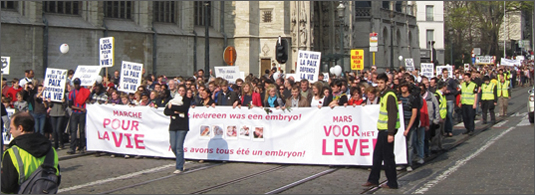
Marie-Emmanuel André-Dumont, baby in her arms, leads the Belgian March for Life along the Rue de la Regence, Brussels, March 27 [Photo by Eric Scheidler]
This past March I visited the key European nation of Belgium for a week of speaking, training and activism. Though small, Belgium is playing a major role in Europe, both because the European Union is headquartered there, and because a growing movement of Belgian pro-life youth is revitalizing the fight against abortion.
I became involved with the Belgian Youth for Life group last November, when I visited Dublin, Ireland to speak at the Viva La Vida pro-life youth conference hosted by Youth Defence, the group which has almost single-handedly kept abortion out of the Republic of Ireland. Several Belgian students attended the conference, and we spent many hours discussing pro-life activism and what might be possible in Belgium.
Among the students was a dynamic leader, Liesbeth Ronsmans, who urged me to come to Belgium for a week of training and activism in advance of their March for Life on March 27. My good friend Bryan Kemper, director of Stand True Ministries, based in Ohio, was also planning to be there and encouraged me to join him.
I was tremendously impressed with the faithfulness and enthusiasm of the Belgian pro-life youth, and I could see what a vital role the Pro-Life Action League might play in energizing pro-life activism in Continental Europe. It was clear that I was being called to visit Belgium this spring.
Respite in the English Countryside
When booking my travel plans from Chicago to Brussels, I realized that at no additional expense I could fly into London, England and take the Eurostar train to Brussels, by way of the Channel Tunnel. This would allow me to visit my friend James Fitzgerald and his family in England the weekend before the Week for Life.
James and I became friends through an e-mail discussion group on Pope John Paul II’s Theology of the Body, and later stayed in touch through Facebook. But until he picked me up from Heathrow Airport after my overnight flight, we had never met in person.
James, his wife Anna and their five young children live on a small farm just outside London, along with several other Catholic families. I had a wonderful time with this beautiful, faithful family—an ideal preparation for the heavy week of speaking and activism to come.
I also had the opportunity to speak to a gathering of English pro-lifers at James’ home on what’s happening in pro-life in the U.S. They were encouraged to hear about the vitality of the American pro-life movement—and how activism is coming to Europe.
CLOSED: 99 Façons
I arrived in Brussels by Eurostar from London on the morning of Monday, March 21, and was picked up from the Midi station by Michel De Keukelaere, one of the leaders of Youth for Life, and Jeroen Declercq. Jeroen took the week off of work to serve as a driver for the Week for Life, and proved to be one of the most dedicated pro-life stalwarts I’ve met on either side of the Atlantic Ocean.
Michel, Jereon and I drove to Brussels’ spectacular Grand Place and met up with Bryan Kemper and three young American activists from Survivors, based in Los Angeles—Ashley Colantuono, Hannah Bucket and Charles Baldwin—along with Antony Burckhardt, another leader of Youth for Life who hails from France. We were soon joined by Liesbeth Ronsmans—the student I had met in Dublin.
After lunch at Café Brouette, the group walked a few blocks to Michel and Antony’s apartment to give the weary American travelers a chance to rest. Antony proudly showed me his copy of CLOSED: 99 faḈons de faire cesser l’avortement—the French edition of my father’s book on pro-life activism!
Encouraging the Youth for Life
After a brief nap, we caught the Metro across town to the home of the André-Dumont family, one of many large European families I’ve had the privilege to meet through my pro-life work. The three oldest of the seven André-Dumont children—Anne-Chantal, Marie-Emmanuelle and Marguerite-Marie—are active with Youth for Life. The Survivors would be staying with them for most of the week.
Our group soon grew to over a dozen, as several other members of Youth for Life arrived for dinner and pro-life talks by the American activists. Bryan, Ashley and I encouraged the Belgian pro-lifers not to be afraid to defend their pro-life beliefs in public, and I passed out copies of the League’s handbook, Sharing the Pro-Life Message, to help them do so. We also shared tips on using new media to advance the cause.
I urged the group to make praying and counseling at abortion clinics a priority. Protest and public education are important, but the most important front in the abortion battle is right there at the abortuaries, where unborn Belgian babies are being killed in the womb. The other American activists agreed, and the group was receptive to this message.
After the meeting, Bryan, Jereon and I drove with Liesbeth to her family’s home in Mechelen, about an hour from Brussels, where we stayed our first two nights.
A Belgian Pro-Life Veteran
Our schedule for Tuesday allowed for Bryan and me to sleep in, helping to take the edge off of our jet-lag. It was a good thing we did, because this would be a busy day.
After a light breakfast, the four of us—Jeroen, Liesbeth, Bryan and I—drove to the college town of Leuven, where Liesbeth is a student, to pick up some large fetal development posters and some literature. Then we were off to Ghent, another college town, where we reconnected with Michel and the Survivors.
Shortly after arriving in Ghent, we met up with one of Belgium’s few pro-life veterans, Lionel Roosemont, and his teenage daughters Sonja and Theresa. Lionel and I hit it off straight away; he was familiar with my father, having met him at the March for Life in Washington, DC some years ago.
During our time together, Lionel told me about his other daughter, Tikvah, who is severely disabled. Doctors for the Belgian national health service had pressured Lionel and his wife to abort Tikvah when her condition was discovered during pregnancy, insisting that she would probably die before birth anyway, if not immediately thereafter.
The Roosemonts refused to kill their daughter, who is now 13. Caring for her has been a source of tremendous blessing for the family, and inspired Lionel to become an outspoken opponent of abortion and euthanasia. He was overjoyed to see the new surge of enthusiasm among Belgian pro-life youth.
Pro-Life on Campus for the First Time
After a quick lunch, our group headed onto the campus of Ghent University, bringing pro-life activism there for the first time in its 200 year history. We held the fetal development signs we’d picked up that morning and passed out flyers outside the philosophy department.
The reaction from students was markedly different from what one would expect in America. First, we encountered no pro-life students at all; even on America’s most liberal campuses, there are some pro-life students.
The students were quite willing to talk about the abortion issue—every one of our small group of activists was engaged in conversation—but they were distinctly lacking in passion. Abortion was clearly not something they’d given much thought to. They accepted it as a routine medical procedure, without any moral implications.
The one exception was a self-proclaimed socialist, who quickly put together a flyer calling for a counter-protest of the March coming up that Sunday, complete with the feminist “fist” logo that we often encounter back home. But even he was mild in comparison with his violent socialist counterparts in the U.S. The counter-protest never materialized.
Talking with the Belgian students, I was struck by how quickly the issue of children with disabilities came up. They seemed to have an almost pathological fear of having to take care of someone. I spoke with a young man who dispassionately told me he would leave his girlfriend if she became disabled, and he would expect her to do the same. He said there’s no such thing as unconditional love.
As disturbing as it was to encounter such pessimism, confronting it was gratifying. The conversations our protest sparked were long overdue, and we gave those students a great deal to think about.
God’s Call to Holiness
Following our afternoon of spiritual warfare at Ghent University, Michel led us to St. Stephen Monastery, established by Augustinian monks in 1295. The monks treated us to a tour, evening Mass and some of their legendary Augustijn beer.
After this restorative visit we headed to a meeting room at the Kapittel Huis restaurant, where we were joined by more pro-life students. Bryan and I spoke about how desperately their commitment to the cause must be translated into activism of the kind we’d brought to Ghent University that day. I showed them a video I’d shot that afternoon so they’d all know exactly what we were talking about.
Lionel Roosemont also offered some words of encouragement to the group, emphasizing that we can do nothing without God. He exhorted all of us to answer God’s call to holiness in our own lives; only then can we effectively witnesses to others.
Activism at the E.U. Parliament
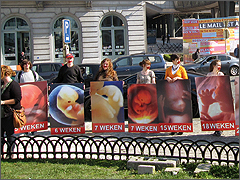
Protest outside the E.U. Parliment in Brussels in silent solidarity with the voiceless children in the womb, March 23 [Photo by Bryan Kemper]
On Wednesday, March 23, about twenty pro-lifers gathered in Brussels at the Place Luxembourg, beside the European Union Parliament complex, for a silent protest. We wore red tape marked with the word “LIFE” over our mouths, in solidarity with the voiceless victims of abortion, as we held our large fetal development signs.
Several pro-life students attempted to pass out leaflets on the E.U. Parliament grounds, but police forbade them. It was an eye-opening experience for an American activist to see what things are like in a country that lacks not only the First Amendment, but the robust ethos of free speech that we take for granted back home.
Among the pro-life youth I met at the protest was Dries Goethals, former power-lifting champion of Belgium and a recent convert to Catholicism. Dries is bringing prayer witness to Belgium’s abortion clinics for the very first time through a project dubbed the “Santa Claus Movement” after St. Nicholas, who is said to have miraculously brought three butchered children back to life, a fitting symbol for the effort to save babies from abortion.
That evening, Liesbeth had scheduled Bryan and me for talks at the Catholic University in Louvain-la-Neuve, which were to be open to both pro-life and pro-choice students, but University officials canceled the event. Bryan and I took advantage of our free time to visit the Natural Café, with free WiFi, to catch up on e-mail and other work.
That evening we moved our bags to the apartment of brothers Thomas and Pietr Decock in Vorst, a Brussels suburb. We would spend the next four nights there.
Thanks, Guardian Angel
The next morning, Thursday, March 24, Thomas Decock dropped me off at the Midi station to catch the Metro into the city center for a session of the Week for Life taking place at the E.U. Parliament. But once inside the massive station, I found there were no clear signs to direct me to the Metro.
As I looked around in confusion, I heard someone call my name. It was Mark Roosemont, Lionel’s son, who had attended my talk in Ghent. He happened to be on his way to the Metro, too. How strange to stumble upon one of the few people I know in the whole of Belgium, right when I needed help! I thanked my guardian angel for setting that up.
However, my difficulties with the Brussels Metro were not over. As the subway approached my stop, I noticed it wasn’t slowing down. In fact, the train sped on through my stop and the next one; they were both closed that morning for maintenance.
I got off at the next station and walked back two miles to the E.U. Parliament. It just so happened that on that day the socialists had called for a demonstration in Brussels, protesting cutbacks in government programs. As I drew closer to the Parliament, I saw more and more protesters wearing the bright red of the socialists.
I learned that the only kind of protest activity Belgians are accustomed to is this sort of socialist demonstration. Until now, they’ve never beheld the kind of dynamic pro-life protest that Americans see so much of.
Pro-Life at the E.U. Parliament
I made it to the E.U. Parliament—a vast series of futuristic buildings reminiscent of a space station—in time to hear a pro-life speaker from Spain describe how the abortion culture undermines democracy by making people docile and easy to control. Speakers from Italy and the Netherlands spoke on the specious “quality of life” standards that are used to justify abortion and euthanasia.
The Week for Life was organized by Elizabeth Hickson, an itinerate American missionary who has been helping the Belgian pro-life movement get on its feet. For the first time, the case for the pro-life cause was exhaustively entered into the official proceedings of the E.U. Parliament, laying the groundwork for pushing back against the tide of abortion and euthanasia.
Police Halt Leafleting in Leuven
After the session, our group of American and Belgian pro-lifers, now joined by activists from Ireland, traveled to Leuven for another street protest, half by train and half by car. Those of us who went by train arrived first, with enough time to visit the shrine of St. Damien of Molokai, a Belgian priest who sacrificed his life ministering to lepers in Hawaii in the late 19th century.
Once we’d regrouped, we set up our fetal development signs outside the Leuven train station and started passing out flyers. A police officer soon arrived, complaining that we didn’t have a permit. As Liesbeth and Bryan tried to convince him we didn’t need one, I texted my office back in the U.S., where the work day was just starting, to see if they could hunt down some proof.
The police officer soon left to seek guidance from his superiors, and our protest proceeded. Like in Ghent, we found the public willing to talk but essentially indifferent to the pro-life message.
Passing out flyers to a group of young people, I noticed that one of them was wearing a Rosary around his neck. I asked him if he ever prayed it, at which point his friends began to tease him. Some of them accused him of being Catholic, while others accused him of being gay. He was much more upset about being accused of being Catholic, an indication of how socially unacceptable religious faith has become in Belgium.
After a while, the policeman returned and ordered us to stop leafleting. Fortunately, we had just about wrapped up our time at the station, and told him so. We began to gather our signs, but the policeman grew impatient and threatened to arrest us and confiscate our signs and leaflets.
I’ve encountered this kind of thing often enough back home, but never without having both the letter of the law and a team of pro-life lawyers on my side. Clearly the Belgian pro-life movement would need to start building the kind of legal support network we enjoy in the United States, with groups like the Thomas More Society to turn to when police make trouble.
Belgium Needs to Face the Truth
Leaving the belligerent police officer behind, we made our way to Mass on the campus of the Catholic University of Leuven. After dinner, we joined a group of university students in a classroom for another pair of talks from Bryan and me.
I started off with a surprise: playing “Oh Susanna” on my harmonica. I explained that in 1986, as a student, I had visited Belgium. Short of money, I had decided to throw my hat down and play harmonica on the street. It wasn’t going well until a group of students had pity on me, giving me enough change for a Belgian waffle and a small bottle of wine. Belgian students have had a special place in my heart ever since.
Moving on, I urged the pro-life students to add graphic abortion signs to their arsenal. It was clear from our protests that week that the Belgian people need a wake-up call. They need to be shocked out of their complacency on abortion by seeing for themselves what abortion does to its unborn victims—that it is not the routine medical procedure they take it for.
Bryan then shared the story of his start in the pro-life movement, encouraging the students that they can make a difference if they have the courage to get involved. He and Ashley from Survivors seconded my remarks about graphic images.
“This Is Science!”
On Friday, our core group of activists concentrated on Brussels, passing out flyers on the March for Life coming up in only two days.
I joined a group on the Rue de la Bourse, near the famous St. Nikolas Church, which I visited. The Church houses relics of the fourth century saint. During my visit, I prayed for the success of the new prayer witness campaign at Belgium’s abortuaries named in his honor.
While we were leafleting, a man passed by Belgian activists Dries, refusing a flyer and declaring “I am a scientist,” as if that settled the issue. Dries immediately whipped out a fetal model from his pocket and replied, “You’re a scientist: this is science.” The man walked off, but I was impressed by Dries’ quick thinking.
Our group later moved on to the picturesque Grand Place, but found it hard to pass out flyers in such a touristy area. As we were leaving, three men came up to say they were in town for the March from Italy—and that the first Italian March for Life is being planned for later this year.
The day concluded with a pro-life student Mass at St. Jacques Church for the Feast of the Annunciation. During Mass I saw a pregnant woman going up for Communion, and suddenly realized she was the first pregnant woman I’d seen in Belgium. Annunciation Mass was the perfect occasion to pray for more openness to life in the country.
Praying at the Abortuscentrum
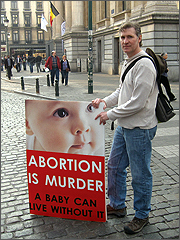
Eric during Brussels leafleting campaign, March 26 [Photo by Charles Baldwin]
On Saturday morning, an international group of twenty pro-lifers—activists from America, Ireland, France and Brazil—gathered at one of Brussels’ abortion clinics to pray. I had suggested this idea to Dries earlier in the week, and he embraced it wholeheartedly, bringing along some sturdy posters he had just had made for the Santa Claus Movement.
The Sjerp-Dilemma Abortuscentrum was a nondescript building on the campus of the Free University of Brussels. It was closed on Saturdays, which would be unusual for an abortion facility in the U.S. It was a strange experience to be at an abortion clinic without heavy fencing, security cameras and warning signs. I felt strange walking straight up to the door to take pictures.
First, Bryan and I led the group in praying the first ten Psalms. We then prayed the Rosary in five languages: English, Latin, Dutch, French and Irish, concluding with the Litany of Loreto in Latin, led by Human Life International‘s Raymond de Souza, whom I had met at the E.U. Parliament Thursday.
Returning to the Grand Place that afternoon, we stumbled upon a curious site: a circle of people singing hymns. I couldn’t place the language, but I recognized the tune: “How Great Thou Art,” one of my favorites. I spontaneously joined the circle, singing along in English. The Survivors joined me, but the more reserved Belgians were reluctant. I was delighted to learn between hymns that the singers hail from Romania; I attend a Romanian Catholic church back home.
After singing along with “Amazing Grace,” we regrouped near the Church of the Madeleine. Liesbeth proudly showed us a feature story in one of the francophone Brussels newspapers on her and the other leaders of Students for Life—an attractive group putting a new face on the pro-life movement in Brussels.
A European “Union”?
While most of the group spread out to continue leafleting, I made my way to the Natural Café again to get some work done. With help from my assistant Matt back home in the U.S., I uploaded the video I had taken of the activism in Ghent, and posted it on Facebook and the League website.
A big gathering was planned that evening at the Place Jourdan, where one could buy huge paper cones of Belgian “frites” (fries) with the traditional mayonnaise and other sauces. I walked there from the café, passing through Brussels Park and Leopold Park, beautiful even in the early spring, and scoped out Chez Bernard as the perfect place to meet, with its large, enclosed back porch.
During the evening—with the pro-life movements of Belgium, France, Spain, Italy, Ireland and the United States all represented—I was struck by the vast cultural differences among Europeans. In particular, the reserved French and Belgians seemed the cultural opposites of the fiery Irish. Irishmen Jamie Nagle and Charlie Quinn sang rousing folksongs to the dismay of the francophone bartender, as I marveled anyone could expect Europe to come together as one state.
“Viva La Vida!”
Bryan and I awoke early Sunday, March 27 and headed into the Brussels city center. After Mass at the Church of the Madeleine, we walked over to the Place de l’Albertine, where the stage was set up for a pre-March rally. Hundreds of people were already gathered there, and the crowd continued to grow by the minute.
As I waited for the program to begin, I caught sight of Michael Botze, one of the leaders of the German group Jungend für das Leben
(Youth for Life), who introduced me to another German activist, Klaus Steigert, one of the few salaried pro-life activists in Europe. We discussed the challenges they’re facing in Germany, where city governments have been trying to halt sidewalk counseling. Klaus encouraged me to return to Europe in September for the March for Life in Berlin.
The rally began at 1 p.m., with speakers from all across Europe and the United States. Nearly every speaker repeated the slogan popularized by Ireland’s Youth Defence, “Viva la vida!”—”May life live!”—which has become the byword of the European pro-life movement.
Michel had asked me to sing something when my turn came. I spoke about the desperate need for God’s grace I had seen that week in Belgium, as well as the tremendous outpouring of His grace within the growing Belgian pro-life movement. Then I led the crowd in singing “Amazing Grace,” the pro-life movement’s anthem.
March for Life, Brussels
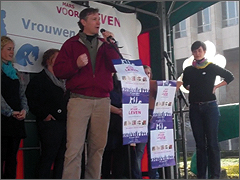
Eric leads “Amazing Grace” before the March for Life, March 27 [Photo by Charles Baldwin]
At 3 p.m. the March began, with the lovely Marie-Emmanuel André-Dumont leading with a little baby in her arms—a striking pro-life image picked up by every media outlet that covered the event. Marie-Emmanuel was followed by a street-wide banner reading “March for Life” in both French and Dutch, with a slogan borrowed from Youth Defence’s billboard campaign: “We all were once embryos!”
Thousands of pro-lifers, spanning several blocks, marched behind the banner for the 1.2 kilometers from the Place de l’Albertine to the Palais de Justice. Oddly, the street cars along the route continued to run during the March, requiring the parade marshals to press the crowd onto the sidewalk several times. This illustrated once more the need for a legal team to protect the Belgian activists from this kind of security hazard and second-rate treatment.
The March concluded with a brief rally at the Palais de Justice, with a powerful statement on the sanctity of life by the Most Rev. André-Joseph Léonard, Archbishop of Mechelen-Brussels. He was the only one of Belgium’s eight bishops to accept an invitation to take part in the March, a sign of how weak the Church has become there.
I took the stage with Bryan and Dries to encourage the crowd to get active praying and sidewalk counseling at the Belgian abortion centers. We beheld an enthusiastic crowd of Belgians young and old, with banners from pro-life groups as far away as Poland.
Next year’s March was announced for March 25, and the hope is to make it the major pro-life March in Europe. After all, Brussels is the capital of the E.U.—and Belgium is arguably the most secular country on the continent.
Belgian Press Covers March
That afternoon, after a long walk through the cobblestone streets of Brussels, I met back up with Michel and Antony at their apartment near the Grand Place, where we checked out the television coverage of the March. Several stations had coverage, and their stories were quite fair, showing the youth and enthusiasm of the Belgian pro-lifers.
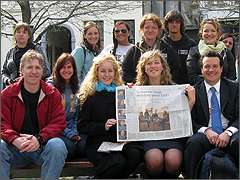
Pro-life activists in Brussels celebrate a feature story in a French Belgian newspaper on Lisbeth Ronsmans (center) and the Youth for Life leaders
The news reported over 3,000 attendees, which sounded right. This was nearly double the attendance of the 2010 inaugural March—but the press had said it was only 600. Thanks to their false reporting last year, they made it look like the March had grown by a factor of six!
Later that evening, I bid adieu to my new Belgian pro-life friends and headed off with Jeroen, Bryan and the Survivors to the town of Kortrikj, where Jeroen had arranged for us to spend the night at the Catholic residence where he lives.
Moving Visit to Ypres
With the Brussels March for Life now behind us, we Americans had a free day on our hands. We decided to visit the beautiful medieval town of Brugge, where one can scarcely take three steps without wanting to take another picture.
We were met there by Lionel Roosmont, who had offered to take us on a guided tour of the town of Ypres, where he is a professional tour guide. Ypres was a critical battle site during World War I. Its few square miles were the scene of the highest concentration of wartime casualties in human history.
In Ypres, the Allies had stopped the advancing Germans, who had violated Belgian neutrality in an effort to conquer France. Had they failed, the Germans would have seized the Belgian ports, and history would have taken a very different course.
So vast was the loss of life, that even now, dozens of soldiers’ remains are found every year by the local farmers. Nearly a hundred years since the end of the war, fresh graves are still being dug. Shells are still churned up out of the ground by tractors, and disposed of by the army.
Lionel was an excellent guide. Many tour groups come through Ypres every year from throughout the English-speaking world, since so many fathers, grandfathers and great-grandfathers are buried there, in cemeteries that appear around every corner. I reflected on how history may one day look back in a similar way on the slaughter of abortion, and wonder how it could have happened.
After our tour, we ate dinner at Lionel’s house, prepared by his gracious wife Renata. I had the opportunity to meet Tikvah—the disabled daughter Lionel and Renata had been urged to abort—and the Roosmonts treated us to a favorite Dutch hymn in three-part harmony.
That evening I drove back to Brussels with Dries and Bryan, while the Survivors made their way by train. Dries dropped me off at a hotel near the Midi Station so I could catch the Eurostar back to London the next morning, then the London tube to Heathrow, and my flight back home.
New Hope for Europe
In many ways, my visit to Belgium confirmed the impression I already had that Europe is in a sorry state. The apathy of the Belgian people on the abortion issue, their disinterest in religion, their abject fear of suffering—no culture can survive long in a state of such moral and spiritual decay.
But at the same time, I discovered something that we hear too little of: new life is springing up in Europe, through the faith and courage of a small but dynamic group of young, pro-life Christians. They are proclaiming the pro-life message with singular zeal and enthusiasm. They are the great hope of Europe.
I also gained a new perspective on the pro-life fight here in the United States. For all the challenges that we face, for all the defeats that we suffer, the pro-life movement here has been tremendously blessed. Our activists are taking the fight for life to the streets in growing numbers. Our elected officials are advancing pro-life legislation in state after state. Our pregnancy centers are saving thousands of mothers and children from abortion every year. Our generous donors are continually sacrificing to make it all possible. No other nation can boast of such commitment to the cause.
To whom much is given, much is expected. I am honored to have had this opportunity to share the hard-won expertise of the American pro-life movement with my new friends in Europe. Through events like the Week for Life in Belgium, we are working together to build a new, global pro-life movement—a movement that is going to change history.

